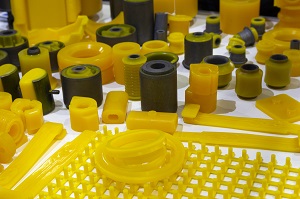What are the Differences Between Subtractive, Additive, and Molding Manufacturing?
Manufacturing processes fall into three categories: additive, subtractive, and molding. Which one is right for your application?
Subtractive Manufacturing
Subtractive manufacturing creates a final product by removing material from a workpiece. Subtractive manufacturing, also known as machining, uses a variety of tools to shape and form a workpiece, including drills, saws, and milling machines, to shape and form the material. Subtractive manufacturing processes include CNC machining, electrical discharge machining (EDM), laser cutting, and water jet cutting.
Additive Manufacturing
Additive manufacturing, also known as 3D printing, takes the opposite approach. In the additive manufacturing process, a product is created by adding material layer upon layer until the desired form is achieved. There are many types of additive manufacturing technologies, including stereolithography (SLA) and fused deposition modeling (FDM).
Molding Manufacturing
In molding manufacturing (also known as forming manufacturing), a mold is used to create a product. A liquid material (plastic, metal, rubber, polyurethane, etc.) is poured into a mold made in the form of the product being produced. As the liquid material cools, it takes the form of the mold’s design. Injection molding and urethane casting are two types of molding manufacturing.
Why Are More Houston, TX Businesses Choosing Additive Over Subtractive Manufacturing?
Traditionally, manufacturers have relied on subtractive manufacturing processes to produce a part. However, with advances in technology, more and more companies are realizing the benefits of additive and form manufacturing.
Additive manufacturing provides many advantages over traditional subtractive manufacturing methods, including:
- The ability to produce parts with complex geometries and intricate designs.
- Additive manufacturing can produce design and engineering prototypes more rapidly and at less cost than other methods.
- Only the required amount of material to create a part is used, reducing waste and cost.
- Parts can be easily customized
- Additive manufacturing allows for on-demand production; companies can produce only the number of parts they require at a given time, eliminating the need and expense of maintaining large inventories of a particular item.
3D printing is used for many applications across a wide range of industries, including aerospace, defense, medical, consumer products, automotive, construction, and more.
Molding manufacturing provides many advantages as well. These advantages include shorter production time, high accuracy, and repeatability, as well as the ability to produce complex shapes and designs. Industries that use molding manufacturing include automotive, aerospace, medical, consumer goods, etc.
3D Printing and Urethane Casting in Houston, TX
Let ProTek Models and 3D Printing show you how additive manufacturing and molding manufacturing can help your business. We provide high-quality, cost-effective SLA and FDM 3D printing services as well as urethane castings to businesses throughout the Houston area. Our team of highly experienced designers and engineers is here to help you every step of the way.
Located in Conroe, TX, just north of Houston, ProTek Models and 3D Printing serves businesses and organizations throughout the Lone Star state. Our clients include Boeing, NASA, Lockheed Martin, Oceaneering, the U.S. Air Force, Mitsubishi, Saleen Automotive, and Circor Energy, to name a few. In addition to 3D printing and urethane casting, we also create durable, highly detailed scale models.
You can contact us through our website or call ProTek Models at (832) 968-6636 to get a price quote and learn more about our Houston, TX additive manufacturing, urethane casting, and custom scale model-making services.


